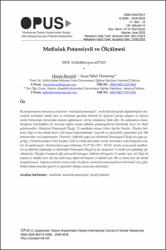Mutluluk Potansiyeli ve Ölçülmesi
Citation
BACANLI, Hasan & Ayşe Sibel DEMİRTAŞ. "Mutluluk Potansiyeli ve Ölçülmesi’’. Uluslararası Toplum Araştırmaları Dergisi, 15.10. Yıl Özel Sayısı (2020): 4701-4722.Abstract
Bu araştırmanın konusunu oluşturan “mutluluk potansiyeli”, mutluluk düzeyinin değişkenliğine (durumluk mutluluk) odaklı olan ve mutluluk yaratma ihtimali ile ilgilenen görüşe dayanır ve kişinin
içinde bulunduğu durumdan doyum sağlamasını, sevinç duymasını ifade eder. Bu çalışmanın amacı,
bireylerin belirledikleri bir duruma ilişkin mutlu olabilme potansiyellerini belirlemek üzere bir ölçek
geliştirmektir. Mutluluk Potansiyeli Ölçeği, 11 maddeden oluşan Likert tipi bir ölçektir. Ölçekte; beklenti, bilgi ve haz olmak üzere 3 alt boyut bulunmaktadır. Geçerlik ve güvenirlik çalışmaları için 306
katılımcıdan veri toplanmıştır. Önerilen 3 faktörlü yapı için Mutluluk Potansiyeli Ölçeği’nin yapı geçerliği, 278 katılımcıdan (%63’ü kadın, %36’sı erkek) elde edilen veriler üzerinden temel bileşenler analizi ile saptanmıştır. Katılımcıların yaş ortalaması 31.97’dir (SD = 10.28). Analiz sonucunda maddelerin üç faktörde toplandığı ve Mutluluk Potansiyeli Ölçeği’ne ait varyansın % 64.86’sını açıkladığı görülmüştür. Ölçeğin Cronbach alfa güvenirlik katsayısı, beklenti alt boyutu (3 madde) için .65, bilgi alt
boyutu (3 madde) için .64, haz (davranış, ifade) alt boyutu (5 madde) için .88, ve tümü için .86 olarak
hesaplanmıştır. Yapılan analizler sonucunda, bireylerin mutluluk potansiyellerini belirlemek için geliştirilen ölçme aracının geçerli ve güvenilir olduğu sonucuna varılmıştır. The potential for happiness which is the subject matter of this research, is based on the perspective that
is focused on the variability of happiness level (state-happiness) and related to the possibility of creating
happiness and it represents the satisfaction of the person in the situation. The purpose of the current
study is to develop a scale in order to assess the potential for happiness of individuals related to the
situation they have identified. The Happiness for Potential Scale is a Likert-type scale consisting of 11
items. The scale has three factors: expectation, knowledge and pleasure. To conduct the validity and
reliability study of the scale, the data were collected from 306 participants. The analyses were conducted
with 278 participants (63% females and 36% males) after missing observations and outliers were excluded from the data set. The participants' mean age was 31.97, SD = 10.28. The results showed that
the items were accumulated under three factors and explained 64.86% of the variance in The Potential
for Happiness Scale. Cronbach’s alpha coefficient was calculated as .65 for expectation factor (3 items),
.64 for knowledge factor (3 items) and .88 for pleasure (expression) factor and .86 for the total scale.
Based on the findings from the analyses, it could be concluded that the scale which was developed in
order to determine the potential for happiness of individuals is a valid and reliable measurement tool.



















